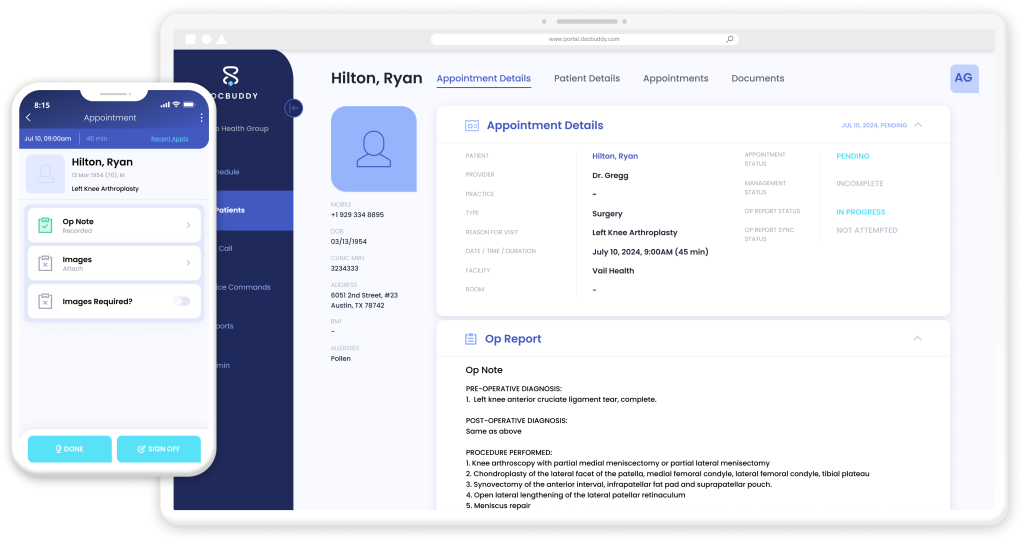The Old Way: ASC Transcription Services
In today’s fast-paced healthcare environment, Ambulatory Surgery Centers (ASCs) are under increasing pressure to optimize their operations while maintaining exceptional patient care. Yet many facilities continue to rely on outdated transcription workflows that create unnecessary bottlenecks and drain valuable resources.
Traditional ASC transcription services involve a cumbersome process: surgeons record their operative notes, send them to third-party transcriptionists, wait for the completed documents, review them for accuracy, and finally provide their signatures. This antiquated approach is at odds with the modern ASC’s need to do more with less.
As healthcare continues to evolve, technology has become the key differentiator between facilities that thrive and those that struggle. The solution lies not in optimizing old processes, but in embracing new digital workflows that fundamentally transform how ASCs operate.
Hidden Cost #1 – Time to Bill
The industry average time-to-bill for ASC procedures stands at 15 days post-operation. This metric varies significantly across facilities – while some high-performing centers might achieve faster turnaround times, others struggle with even longer delays. These extended billing cycles directly impact cash flow and financial stability.
Consider the implications of this delay: for two weeks or more, completed procedures sit in administrative limbo, preventing ASCs from submitting claims and receiving payment for services rendered. This gap between service delivery and reimbursement creates unnecessary financial strain on facilities.
Modern solutions like DocBuddy Op Note are revolutionizing this process. By enabling same-day billing through immediate operative report completion and approval, ASCs can dramatically accelerate their revenue cycle. When surgeons can complete and sign operative reports instantly from their smartphones, the traditional two-week billing delay becomes a thing of the past.
Hidden Cost #2 – FTE Cost to Manage Image Processes
While not every operative report requires images, those that do present a unique challenge under traditional workflows. The manual process of printing images and physically incorporating them into patient charts is both time-consuming and resource-intensive. Staff members spend countless hours managing this paper-based system, leading to significant FTE costs that could be better allocated elsewhere.
The digital revolution in healthcare has made this manual image management process obsolete. DocBuddy Op Note offers a streamlined solution where images from any source – C-Arms, imaging towers, or even HIPAA-secure smartphone photos – can be instantly and digitally appended to operative reports. This eliminates the need for physical image handling while ensuring all necessary documentation remains properly organized and readily accessible.
Hidden Cost #3 – FTE Cost for Report Completion and Approval
One of the most frustrating and time-consuming aspects of traditional operative report management is the endless cycle of signature chase-downs. ASC administrators, business office managers, and billing staff invest significant time and energy following up with surgeons to secure their signatures on completed reports. This administrative burden not only creates unnecessary stress but also represents a substantial hidden cost in terms of staff hours and delayed reimbursement.
What if this entire process could be eliminated? DocBuddy Op Note transforms this pain point into a seamless digital workflow. Surgeons can generate, review, and approve operative reports directly from their smartphones, anywhere and at any time. This immediate accessibility means no more tracking down busy physicians or managing stacks of pending paperwork.
The impact of this streamlined approach extends beyond mere convenience. By eliminating the need for signature follow-ups, ASC staff can redirect their time and energy toward more valuable activities that enhance patient care and facility operations. The resulting efficiency gains translate directly to improved financial performance and reduced administrative overhead.
The Real Numbers: Breaking Down the Hidden Costs
When ASCs evaluate their transcription services, they often focus solely on the direct cost of the transcription service itself. However, the true financial impact runs much deeper. Through comprehensive analysis of staff time, administrative overhead, and operational inefficiencies, we’ve identified that the total annual cost of traditional transcription services for a typical ASC can exceed $120,000.
This figure includes not just the basic ASC transcription service fees, but also:
- Staff time spent managing the transcription workflow
- Administrative hours dedicated to following up on pending signatures
- FTE costs for image management and documentation
That’s not even to mention opportunity costs from delayed reimbursements and outright loss of revenue due to timely filing!
The New Way: DocBuddy Op Note
For ASC administrators focused on operational efficiency and financial performance, the scenario is clear: continuing with traditional transcription services means paying for a service loaded with hidden costs that creates delays, increases administrative burden, and hampers revenue cycle management OR do things the new way.
DocBuddy Op Note offers a path to modernization with ZERO hidden costs that gives you the power of instantly generated operative reports with images that can be approved moments after the procedure ends.
Learn all about DocBuddy Op Note here or get in touch with us to schedule a time to see it on our Contact page.

